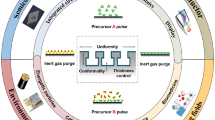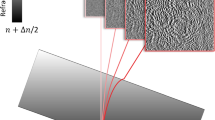Abstract
We study a stochastic model for the self-controlled particle-deposition process induced by optical near-fields. This process was experimentally realized by Yukutake et al. on an electrode of a novel photovoltaic device as Ag deposition under light illumination, in which the wavelength of incident light is longer than the long-wavelength cutoff of the materials composing the device. Naruse et al. introduced a stochastic cellular automaton model to simulate underlying nonequilibrium processes which are necessary to formulate unique granular Ag film in this deposition process. In the present paper, we generalize their model and clarify the essential role of optical near-fields generated on the electrode surface. We introduce a parameter b indicating the incident light power per site and a function representing the resonance effect of optical near-fields depending on the Ag-cluster size on the surface. Numerical simulation shows a transition from a trivial particle-deposition state to a nontrivial self-controlled particle-deposition state at a critical value b c, and only in the latter state optical near-fields are effectively generated. The properties of transition in this mesoscopic surface model in nonequilibrium are studied by the analogy of equilibrium phase transitions associated with critical phenomena, and the criteria of transition are reported.









Similar content being viewed by others
References
M. Ohtsu, T. Kawazoe, T. Yatsui, M. Naruse, IEEE J. Sel. Top. Quantum Electron. 14, 1404 (2008)
S. Tojo, M. Hasuo, Phys. Rev. A 71, 012508 (2005)
M. Ohtsu, Dressed Photons: Concepts of Light-Matter Fusion Technology, Nano-Optics and Nanophotonics (Springer, Berlin, 2014)
T. Franzl, T.A. Klar, S. Schietinger, A.L. Rogach, J. Feldmann, Nano Lett. 4, 1599 (2004)
S. Yukutake, T. Kawazoe, T. Yatsui, W. Nomura, K. Kitamura, M. Ohtsu, Appl. Phys. B 99, 415 (2010)
C. Pistol, C. Dwyer, A.R. Lebeck, IEEE Micro 28, 7 (2008)
T. Kawazoe, M.A. Mueed, M. Ohtsu, Appl. Phys. B 104, 747 (2011)
M. Naruse, N. Tate, M. Aono, M. Ohtsu, Rep. Prog. Phys. 76, 056401 (2013)
M. Naruse (ed.), Nanophotonics Information Physics: Nanointelligence and Nanophotonics Computing, Nano-Optics and Nanophotonics (Springer, Berlin, 2014)
T. Yatsui, W. Nomura, M. Ohtsu, Nano Lett. 5, 2548 (2005)
J. Marro, R. Dickman, Nonequilibrium Phase Transitions in Lattice Models (Cambridge University Press, Cambridge, 1999)
R. Mahnke, J. Kaupužs, I. Lubashevsky, Physics of Stochastic Processes: How Randomness Acts in Time (Wiley-VCH, Germany, 2009)
B. Chopard, M. Droz, Cellular Automata Modeling of Physical Systems (Cambridge University Press, Cambridge, 1998)
M. Naruse, T. Kawazoe, T. Yatsui, N. Tate, M. Ohtsu, Appl. Phys. B 105, 185 (2011)
K. Kobayashi, S. Sangu, H. Ito, M. Ohtsu, Phys. Rev. A 63, 013806 (2000)
Acknowledgments
The present authors would like to thank S. Tojo for useful discussions on the present work. This study is supported by the Grant-in-Aid for Challenging Exploratory Research (No. 15K13374) of Japan Society for the Promotion of Science. MK is supported in part by the Grant-in-Aid for Scientific Research (C) (No. 26400405) of Japan Society for the Promotion of Science.
Author information
Authors and Affiliations
Corresponding author
Rights and permissions
About this article
Cite this article
Takahashi, K., Katori, M., Naruse, M. et al. Stochastic model showing a transition to self-controlled particle-deposition state induced by optical near-fields. Appl. Phys. B 120, 247–254 (2015). https://doi.org/10.1007/s00340-015-6130-0
Received:
Accepted:
Published:
Issue Date:
DOI: https://doi.org/10.1007/s00340-015-6130-0




